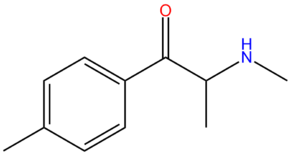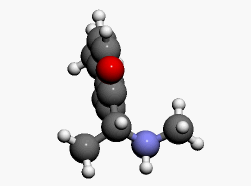Mephedrone
 |
This article is a stub. As such, it may contain incomplete or wrong information. You can help by expanding it. |
Mephedrone, also known as 4-methylmethcathinone (4-MMC) or 4-methylephedrone, is a synthetic stimulant drug of the amphetamine and cathinone classes. Slang names include drone,[1] M-CAT,[2] and meow meow.[3] It is chemically similar to the cathinone compounds found in the khat plant of eastern Africa. It comes in the form of tablets or a powder, which users can swallow, snort, inject or insert rectally producing effects which are somewhat similar to that MDMA, amphetamine and cocaine.
Mephedrone was first synthesised in 1929, but did not become widely known until it was rediscovered in 2003. By 2007, mephedrone was reported to be available for sale on the internet, by 2008 law enforcement agencies had become aware of the compound, and by 2010, it had been reported in most of Europe, becoming particularly prevalent in the United Kingdom.
Chemistry
Pharmacology
Given its chemical structure, mephedrone is likely to act as a releasing agent and a reuptake inhibitor for monoamine neurotransmitters such as dopamine, serotonin and noradrenaline.[4]
Several articles published near the end of 2011 examined the effects of mephedrone in the brains of rats, as well as examining the reinforcing potential of mephedrone. Dopamine and serotonin were collected using microdialysis, and increases in dopamine and serotonin were measured. Mephedrone administration caused about a 500% increase in dopamine, and about a 950% increase in serotonin. They reached their peak concentrations at 40 minutes and 20 minutes and returned to baseline by 120 minutes after injection.
Analysis of the ratio for dopamine and serotonin indicated mephedrone was preferentially a serotonin releaser, with a ratio of 1.22:1 (serotonin vs. dopamine). Additionally, half-lives for the decrease in DA and 5-HT were calculated and found to have decay rates of 24.5 minutes and 25.5 minutes. These findings show mephedrone induces a massive increase in both dopamine and serotonin, combined with rapid clearance. This increase in neurotransmitters provides an explanation for the euphoric and stimulating subjective effects induced by this experience. The rapid rise and subsequent fall of dopamine levels could also explain some of the addictive properties mephedrone displays in some users.[5][6]
Subjective effects
Physical effects
Cognitive effects
Toxicity and Harm Potential
Almost nothing is known about the long-term effects of mephedrone due to its short history of its use.[7] Along side of this, the median lethal dosage remains unknown and unstudied.[8]
Despite similarities to known neurotoxins such as methamphetamine and other cathinone derivatives, mephedrone does not appear to produce neurotoxic effects in the dopamine system of mice.[9]
Tolerance and addiction potential
Legal issues
See also
References
- ↑ Mephedrone: Chemistry lessons | http://www.telegraph.co.uk/health/7614099/Mephedrone-Chemistry-lessons.html
- ↑ Drugs crackdown hailed a success | http://news.bbc.co.uk/1/hi/scotland/north_east/8555872.stm
- ↑ Mephedrone (4-methylmethcathinone; ‘meow meow’): chemical, pharmacological and clinical issues | http://link.springer.com/article/10.1007%2Fs00213-010-2070-x
- ↑ What should be done about mephedrone? | http://www.ncbi.nlm.nih.gov/pubmed/20332508
- ↑ Mephedrone, compared with MDMA (ecstasy) and amphetamine, rapidly increases both dopamine and 5-HT levels in nucleus accumbens of awake rats | http://www.ncbi.nlm.nih.gov/pmc/articles/PMC3246659/
- ↑ 4-Methylmethcathinone (mephedrone): neuropharmacological effects of a designer stimulant of abuse | http://www.ncbi.nlm.nih.gov/pubmed/21810934?dopt=Abstract
- ↑ Clubbers are 'turning to new legal high mephedrone' | http://www.bbc.co.uk/newsbeat/10004366
- ↑ Mephedrone, new kid for the chop? | http://www.ncbi.nlm.nih.gov/pubmed/20735367
- ↑ Mephedrone, an abused psychoactive component of 'bath salts' and methamphetamine congener, does not cause neurotoxicity to dopamine nerve endings of the striatum | http://www.ncbi.nlm.nih.gov/pubmed/22191803

